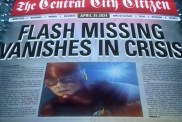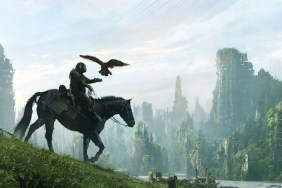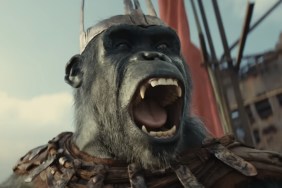
The Darryl F. Zanuck theater on the 20th Century Fox Lot was host this past Wednesday to a special sneak preview of director Matt Reeves’ Dawn of the Planet of the Apes, hosted by Caesar himself, Andy Serkis. Below, you can check out our account of the 20 minutes of footage screened and then sure to check back in the next few days for exclusive WonderCon interviews with the film’s cast and crew!
Please be aware that the following scene descriptions contain minor spoilers for the July 11 release.
“Family, tribalism, empathy and prejudice,” Serkis listed in his introduction as being the primary themes central to the upcoming continuation of the world established in director Rupert Wyatt’s 2011 reinterpretation of the long-running science fiction franchise. While that film borrowed most chiefly from the series’ third sequel, Conquest of the Planet of the Apes, Matt Reeves’ Dawn brings its world that much closer to the “primatocracy” of the 1968 original.
Ten years have passed since the end of Rise. Mankind has been virtually wiped out in the wake of the deadly Simian Flu virus, leaving pockets of survivors struggling to stay alive amidst the ruins of human civilization. Meanwhile, the apes’ burgeoning culture, while not as technologically advanced, is experiencing far more forward momentum. Inside California’s Redwood Forest, Caesar and his followers have constructed a primitive village, slowly expanding their society. Caesar is now wed to a female ape (Judy Greer’s Cornelia) and the pair have a young child (unnamed in the footage previewed, but reminiscent of Escape From the Planet of the Apes‘ baby Milo).
Serkis opened the presentation with a split-screen montage of ape actors coupled with final VFX footage of their respective performances, emphasizing the technical skill required for those for playing non-human characters. Likening the performance capture process to “digital costume and makeup,” Serkis says that everyone playing an ape was required to learn four different types of language: Ape vocalizations, sign language, a rudimentary combination of gesture and sound, and a prototype language slowly being developed within the ape village. All four styles (often in conjunction with one another) were readily on display in the five scenes showcased with the ASL dialogue also displayed as subtitles.

Although the footage was said to be unfinished, Dawn of the Planet of the Apes is clearly prepared to turn quite a few heads with its visual effects. A quantum leap ahead of the already-impressive work done on Rise, Weta’s achievements on Dawn are nothing short of astonishing and, even in their unfinished state, appear photo real.
The first scene opens with two apes standing by an expansive river, spear-fishing with handmade weapons. When they finish, they begin to trek back through the forest and are startled to come across a human being. Terrified to see the apes himself, the man draws a gun and begins to yell. One of the ape pair (whose name is Ash and who is the child of Rise‘s Rocket), is clearly furious and, in the heat of the moment, the man fires at (but does not appear to kill) Ash. The other ape begins to scream just as more humans (led by Jason Clarke’s Malcolm) arrive on the scene. Within moments, the ape village responds as hundreds of them descend from the trees, surrounding Malcolm and his group.
“We mean no harm!” Malcolm shouts. (He’s chastised by another human for it. Mankind doesn’t seem to know that apes can talk yet.)
Caesar looks down on the small band of men, fury in his eyes.
“Go!” he screams with all his might and the humans run away.
“Follow,” he signs to Toby Kebbell’s Koba (taking over the role from Rise‘s Christopher Gordon), also holding back an over-anxious gorilla. In their terror, the humans have left behind a backpack, which the apes are quick to recover.
The next scene moves to the ape council, held in the center of the ape village. Maurice, the wise orangutan, looks through a book that was found inside the backpack. In it are a child’s drawings of what happened during the Simian Flu contagion.
Speaking in ASL and broken English, the council is trying to decide their next move. They can either attack the humans to get revenge for Ash or ignore the assault and continue on. Many are in favor of going on the offensive, but all agree that it is Caesar’s choice. He signs that he doesn’t know how many guns the humans have and doesn’t want to lose what they’ve built, speaking aloud the word, “Future.” He says he’ll have decision by morning.
“Ape must show strength!” Koba tells him.

The next scene jumps over to the human side of things. In the ruins of San Francisco, Gary Oldman’s Dreyfus is preparing for the ape response inside some sort of fortified compound. Outside, the apes arrive, decorated in war paint with many of them on horseback.
“That’s a lot more than 80,” says Dreyfus, who clearly has no love lost for the apes.
Malcolm and a small group (among them Kerri Russell’s Ellie) head outside. Their fear is palpable. As they step from the compound, they look up to see hundreds and hundreds of apes lining the roofs of what used to be The Golden Gate City.
“Apes not want war,” Caesar glares down at Malcolm, then pointing alternately at the woods and the compound. “Ape home. Human home. We fight if we must. Do not come back.”
The apes depart on horseback with one last ape stepping forward to return the backpack.
Serkis offered a bit of a background for the final two scenes. It seems that the human group is attempting to restart a hydroelectric plant and an uneasy truce with the apes is formed, Caesar believing that man and ape can peacefully coexist. Brief and virtually without dialogue, the fourth scene takes place after Caesar has saved several humans from some kind of an explosion and largely showcases Russell’s Ellie playing the very young and very curious son of Caesar.
The final full scene featured Kodi Smit-McPhee’s character, Alexander, who is Malcolm’s son. He’s staying in a tent in the woods and is approached by an orangutan. He goes into his bag and pulls out a well-worn copy of Charles Burns’ “Black Hole” and shows it to the very interested ape. The two sit together on the ground, reading it together, illustrating a potential for peace between man and ape.
The presentation concluded with the same extended trailer and clip that first-premiered at CinemaCon and then screened again at this weekend’s WonderCon. Check back soon as the former, at least, should be online shortly.
Dawn of the Planet of the Apes
-
Bpynmqlimaex6o4

-
Dpa_group_bridge_ver_c_srgb

-
Hr_dawn_of_the_planet_of_the_apes_19

-
Hr_dawn_of_the_planet_of_the_apes_9

-
1932693_636341946414062_2105520245_o

-
Hr_dawn_of_the_planet_of_the_apes_10

-
Hr_dawn_of_the_planet_of_the_apes_11

-
Hr_dawn_of_the_planet_of_the_apes_12

-
Hr_dawn_of_the_planet_of_the_apes_13

-
Hr_dawn_of_the_planet_of_the_apes_14

-
Hr_dawn_of_the_planet_of_the_apes_15

-
Hr_dawn_of_the_planet_of_the_apes_16

-
Hr_dawn_of_the_planet_of_the_apes_17

-
Hr_dawn_of_the_planet_of_the_apes_18

-
Hr_dawn_of_the_planet_of_the_apes_7 3

-
Hr_dawn_of_the_planet_of_the_apes_6

-
Hr_dawn_of_the_planet_of_the_apes_5

-
Hr_dawn_of_the_planet_of_the_apes_4

-
Hr_dawn_of_the_planet_of_the_apes_1







